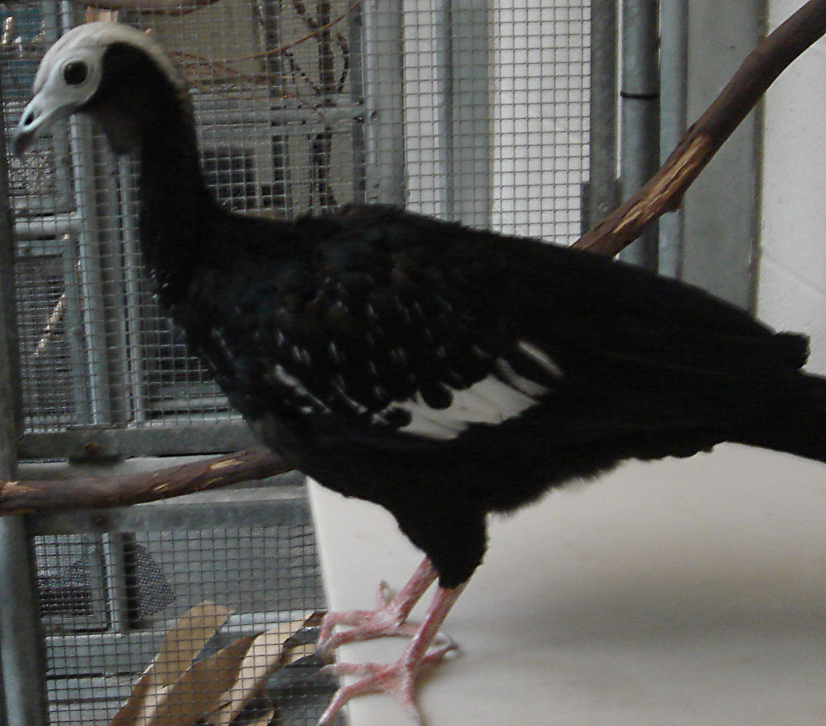- Aburria
image_width = 240px
image_caption = A piping-guan, "Aburria " sp.
regnum =Animal ia
phylum =Chordata
classis =Aves
ordo =Galliformes
familia =Cracidae
genus = "Aburria"
genus_authority = Reichenbach,1853
subdivision_ranks = Species
subdivision =5, see text.
synonyms ="Pipile" Taxobox_authority | author = Bonaparte | date =1856 "Aburria" are the piping-guans, a
bird genus in theCracidae family. Most species were formerly classified in "Pipile", but a recent study (Grau "et al." 2005), evaluatingmtDNA ,osteology andbiogeography data (Grau "et al.", 2005) concluding that theWattled Guan belongs into the same genus as these and is a hypermelanistic piping-guan. Thus, "Pipile" became ajunior synonym of "Aburria", though this conclusion was not accepted by the South American Checklist Committee (Remsen "et al.", 2007).The same results also showed that the light-faced
taxa "pipile, cumanensis" and "cujubi" are not, as was sometimes suggested,conspecific . However, free interbreeding between "A. cujubi" and "A. cumanensis grayi" in eastern Bolivia, creating a "hybrid swarm", casts doubt on this conclusion for the two species named (Remsen "et al.", 2007, citing del Hoyo and Motis, 2004).It was possible to confidently resolve that the white-faced species form a
clade , whereas the more basal black-faced forms are of less certain relationship. Possibly, theBlack-fronted Piping-guan is the basalmosttaxon , but the placement of theWattled Piping-guan in regard to itscongener s is not all too well resolved. Blue wattles evolved only once, in a lineage which seems to have originated north of theAmazon River . The piping-guans' radiation began in the latter half of theEarly Pliocene , roughly 4-3.5 mya. The white-faced lineage emerged around 3 mya and its present diversity began to evolve around the Pliocene-Pleistocene boundary, when the ancestors of theRed-throated Piping-guan and the blue-wattled taxa split. Due to not being calibrated by material evidence such asfossil s, the divergence times cannot be estimated with a high confidence (Grau "et al." 2005).The origin of the genus was possibly in the general area of eastern
Bolivia , at the very margin of its current range. From thephylogeny outlined above, the piping-guans would be expected to have originated in the southernBrazil ian lowlands. However, although the relationships of the genera of guans are not entirely clear, it seems most likely that the group originated in the northernAndes region: The northernmost guan genera "Chamaepetes " and "Penelopina " appear to be basal divergences, and "Aburria" is most likely closer to "Penelope" (which represents a generally southward radiation out of the northern Andes) than to these.Thus it appears most likely that the present genus diverged in the eastern foothills of the Andes somewhere in the vicinity of Bolivia, far to the northwest from where its origin would be presumed from the phylogeny and present-day distribution of "Aburria" alone (Pereira "et al." 2002, Grau "et al." 2005). Two considerations are worthy of note: First, the time at which the ancestor of the piping-guans diverged from "Penelope" has been roughly dated to the
Burdigalian , some 20-15 mya, which leaves a considerable gap during which no surviving piping-guan lineage evolved (Pereira "et al." 2002). Secondly, it is notable that in theLate Pliocene , risingsea level s transformed much of the South American lowlands into brackishlagoon habitat unsuitable for piping-guans. Thus, the present distribution is apparently arelict , andextinction of populations/displacement by the more resilient "Penelope" guans seems to have played as much or possibly more of a role in shaping the diversity of piping-guans of our time than emergence of new lineages (Grau "et al." 2005).Species
*
Black-fronted Piping-guan , "Aburria jacutinga"
*Wattled Piping-guan , "Aburria aburri"
*Red-throated Piping-guan , "Aburria cujubi"
*Trinidad Piping-guan , "Aburria pipile"
*Blue-throated Piping-guan , "Aburria cumanensis"
** Gray's Piping-guan, "Aburria cumanensis grayi"References
* del Hoyo, Josep & Motis, Anna, updated chapter in Delacour, Jean & Amadon, Dean (2004): "Curassows and Related Birds", Lynx Edicions in association with the American Museum of Natural History. ISBN 8487334644
* Grau, Erwin T.; Pereira, Sérgio Luiz; Silveira, Luís Fábio; Höfling, Elizabeth & Wanjtal, Anita (2005): Molecular phylogenetics and biogeography of Neotropical piping guans (Aves: Galliformes): "Pipile" Bonaparte, 1856 is synonym of "Aburria" Reichenbach, 1853. "Molecular Phylogenetics and Evolution" 35: 637-645. doi|doi:10.1016/j.ympev.2004.12.004 [http://individual.utoronto.ca/sergiolp/pdf/MPE2005.pdf PDF fulltext]
* Pereira, Sérgio Luiz; Baker, Allan J. & Wajntal, Anita (2002): Combined nuclear and mitochondrial DNA sequences resolve generic relationships within the Cracidae (Galliformes, Aves). "Systematic Biology" 51(6): 946-958. DOI|10.1080/10635150290102519 [http://individual.utoronto.ca/sergiolp/pdf/SB2002.pdf PDF fulltext]
* Remsen, J. V., Jr., C. D. Cadena, A. Jaramillo, M. Nores, J. F. Pacheco, M. B. Robbins, T. S. Schulenberg, F. G. Stiles, D. F. Stotz, and K. J. Zimmer. Version 21 October 2007. A classification of the bird species of South America. American Ornithologists' Union. http://www.museum.lsu.edu/~Remsen/SACCBaseline.html
Wikimedia Foundation. 2010.

